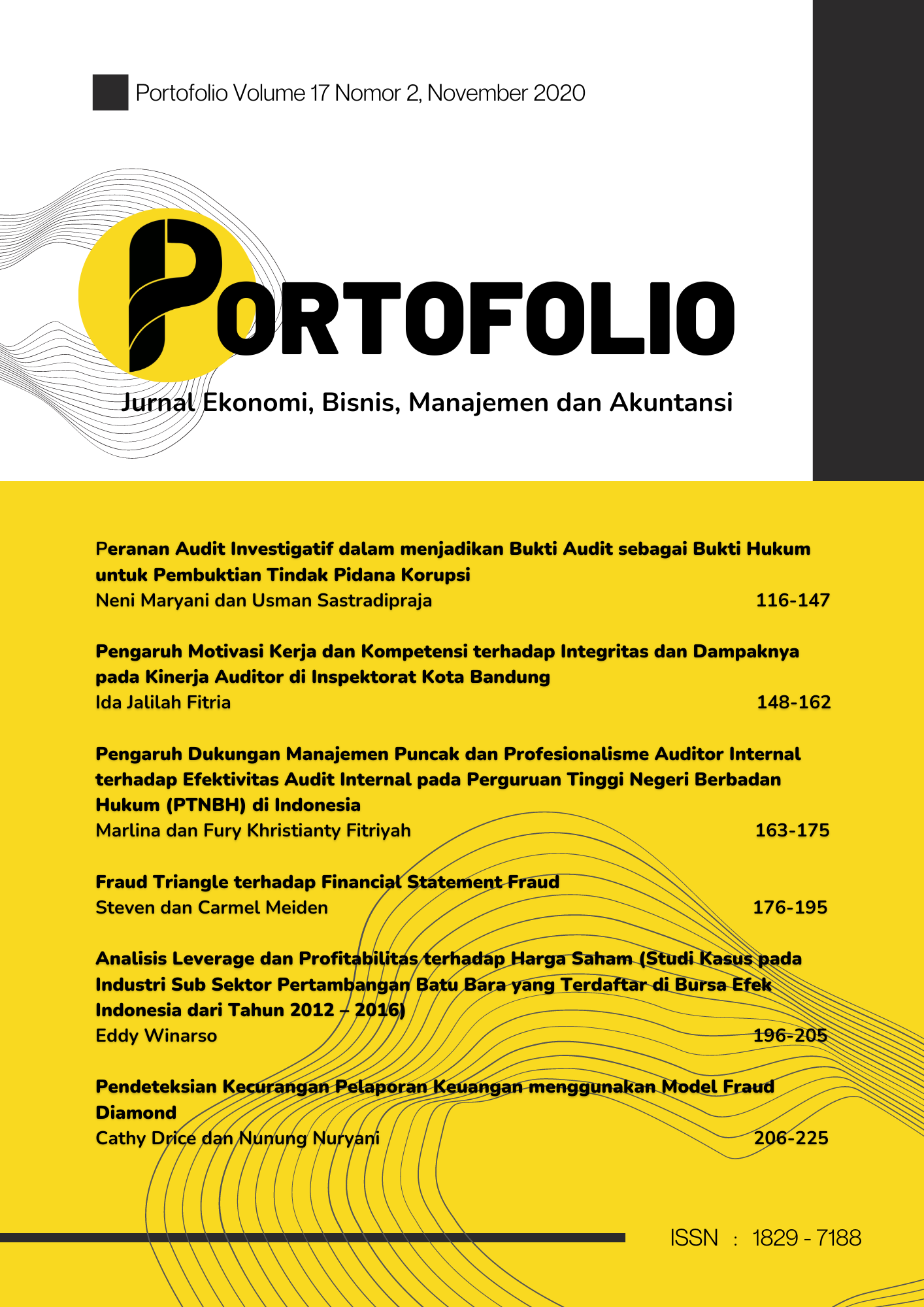Fraud Triangle terhadap Financial Statement Fraud
Abstract
Abstract
This study aims to analyze the effect of the fraud triangle on the financial statement fraud. Based on the theory of fraud triangle, there are three factors: pressure, opportunity, and rationalization. Sampling is done by purposive sampling method and obtained 19 sample companies with 57 observational data of manufacturing companies consumer goods industry sector listed on the Indonesia Stock Exchange in the period of 2017-2019. Hypothesis in this study is tested using descriptive statistics analysis, pooling test, and logistic regression analysis. The conclusion from this study proves that the variables of financial stability, financial targets and nature of industry have a positive effect on the financial statements fraud. While the variables of personal financial needs and ineffective monitoring have a negative effect on the financial statement fraud. However, the variables of external pressure and rationalization have no effect on the financial statement fraud.
Abstrak
Pengambilan sampel penelitian dilakukan dengan menggunakan metode purposive sampling dan diperoleh sebanyak 19 perusahaan sampel perusahaan dengan 57 data amatan pada sektor industri barang konsumsi yang terdaftar di Bursa Efek Indonesia periode 2017-2019. Pengujian hipotesis dalam penelitian ini menggunakan analisis statistik deskriptif, uji pooling, dan analisis regresi logistik. Kesimpulan dari penelitian ini membuktikan bahwa variabel financial stability, financial targets, dan nature of industry berpengaruh positif terhadap financial statement fraud. Sedangkan personal financial need dan ineffective monitoring berpengaruh negatif terhadap financial statement fraud. Namun, external pressure dan rationalization tidak berpengaruh terhadap financial statement fraud.
References
AICPA. (2002). AU Section 316 Consideration of Fraud in a Financial Statement Audit. 99, 113, 167–218.
Ardiyani, Susmita & Utaminingsih, N. S. (2015). Analisis Determinan Financial Statement Melalui Pendekatan Fraud Triangle. Accounting Analysis Journal, 4(1), 1–10.
Arens, A. A., Elder, R. J., Beasley, M. S., & Jusuf, A. A. (2014). Jasa Audit dan Assurance: Pendekatan Terpadu, Edisi 1, Jilid 1, Terjemahan oleh Desti Fitriani, Jakarta, Penerbit Salemba Empat.
Beneish, M. D. (1999). The Detection of Earnings Manipulation. Financial Analysts Journal, 5(June), 24–36.
Beneish, M. D., Lee, C. M. C., & Nichols, D. C. (2012). Fraud Detection and Expected Returns. SSRN Electronic Journal.
Dwijayani, S., Sebrina, N., & Halmawati. (2019). Analisis Fraud Triangle Untuk Mendeteksi Kecurangan Laporan Keuangan (Studi Empiris Pada Perusahaan Manufaktur Yang Terdaftar di BEI Periode 2014-2017). Jurnal Eksplorasi Akuntansi, 1(1), 445–458.
Eisenhardt, K. M. (1989). Agency Theory: An Assessment and Review. In Academy of Management Review (Vol. 14, Issue 1, pp. 57–74).
Ghozali, I. (2018). Aplikasi Analisis Multivariate Dengan Program IBM SPSS 25 (9th ed.), Semarang, Badan Penerbit Universitas Diponegoro.
Hafizah, N., & Respati, Novita Weningtyas, C. (2017). Faktor-Faktor Yang Mempengaruhi Kecurangan Laporan Keuangan Dengan Analisis Fraud Triangle. Jurnal Reviu Akuntansi Dan Keuangan, 6(1), 811–822.
Ijudien, D. (2018). Pengaruh Stabilitas Keuangan, Kondisi Industri dan Tekanan Eksternal Terhadap Kecurangan Laporan Keuangan. Jurnal Kajian Akuntansi, 2(1), 82.
Ikatan Akuntan Indonesia. (2015). Penyajian Laporan Keuangan. Standar Akuntansi Keuangan, 1, 24.
Ikatan Akuntan Publik Indonesia. (2008). SA 240 Tanggung Jawab Auditor Terkait Dengan Kecurangan Dalam Suatu Audit Atas Laporan Keuangan. SA 240, 1–41.
Jensen, Michael C. & Meckling, W. C. (1976). Theory of The Firm: Managerial Behavior, Agency Costs And Ownership Structure. Journal of Financial Economics 3, 305–360.
Pasaribu, R. B. F., & Kharisma, A. (2018). Fraud Laporan Keuangan Dalam Perspektif Fraud Triangle. Jurnal Riset Akuntansi & Keuangan, 14(1), 53–65.
Rachmania, A. (2017). Analisis Pengaruh Fraud Triangle Terhadap Kecurangan Laporan Keuangan Pada Perusahaan Makanan dan Minuman Yang Terdaftar di Bursa Efek Indonesia Periode 2013-2015. Jurnal Online Mahasiswa Bidang Akuntansi.
Sekaran, U., & Bougie, R. (2019a). Metode Penelitian untuk Bisnis Pendekatan Pengembangan-Keahlian, Edisi 6, Jilid 1, Terjemahan oleh Kwan Men Yon, Jakarta, Penerbit Salemba Empat.
Skousen, C. J., Smith, K. R., & Wright, C. J. (2009). Detecting and predicting financial statement fraud: The effectiveness of the fraud triangle and SAS No. 99. Advances in Financial Economics, 13(1), 53–81.
Tiffani, L. dan M. (2015). Deteksi Financial Statement Fraud dengan Analisis Fraud Triangle pada Perusahaan Manufaktur yang Terdaftar Di Bursa Efek Indonesia. Jurnal Akuntansi Dan Auditing Indonesia, 19(2), 112–125.
Utama, I Gusti Putu Oka Surya;Ramantha, I Wayan & Badera, I. D. N. (2018). Analisis Faktor-Faktor Dalam Perspektif Fraud Triangle Sebagai Prediktor Fraudulent Financial Reporting. E-Jurnal Ekonomi Dan Bisnis Universitas Udayana, 1, 251–278.
Utomo, L. P. (2018). Kecurangan Dalam Laporan Keuangan “Menguji Teori Fraud Triangle". Jurnal Akuntansi Dan Pajak, 19(1), 77–88.
Wahyuni; Budiwitjaksono, S. (2017). Fraud Triangle Sebagai Pendeteksi Kecurangan Laporan Keuangan. Jurnal Akuntansi, XXI(01), 47–61.
Yulia Zahro, Nur Diana, M. C. M. (2018). Deteksi Financial Statement Fraud Dengan Analisis Fraud Triangle Pada Perusahaan Manufaktur Yang Terdaftar Di BEI. Jurnal Ilmiah Riset Akuntansi, 07(09), 51–64.
Authors who publish in Portfolio: Jurnal Ekonomi, Bisnis, Manajemen, dan Akuntansi agree to the following terms:
- Authors retain copyright and grant the journal right of first publication with the work simultaneously licensed under a Attribution-ShareAlike 4.0 International (CC BY-SA 4.0) License that allows others to share the work with an acknowledgment of the work's authorship and initial publication in this journal.
- Authors are able to enter into separate, additional contractual arrangements for the non-exclusive distribution of the journal's published version of the work (e.g., post it to an institutional repository or publish it in a book), with an acknowledgment of its initial publication in this journal.
- Authors are permitted and encouraged to post their work online (e.g., in institutional repositories or on their website) prior to and during the submission process, as it can lead to productive exchanges, as well as earlier and greater citation of published work (See The Effect of Open Access).


1.png)






